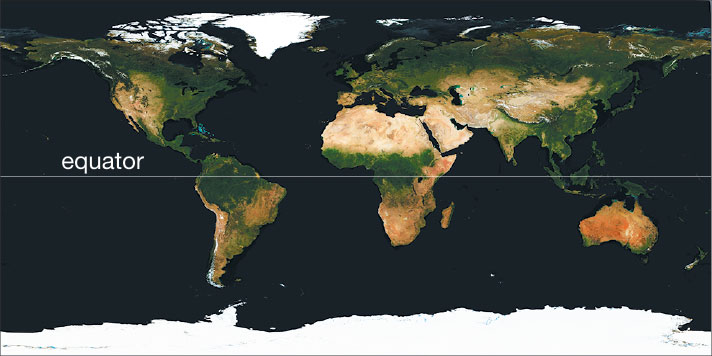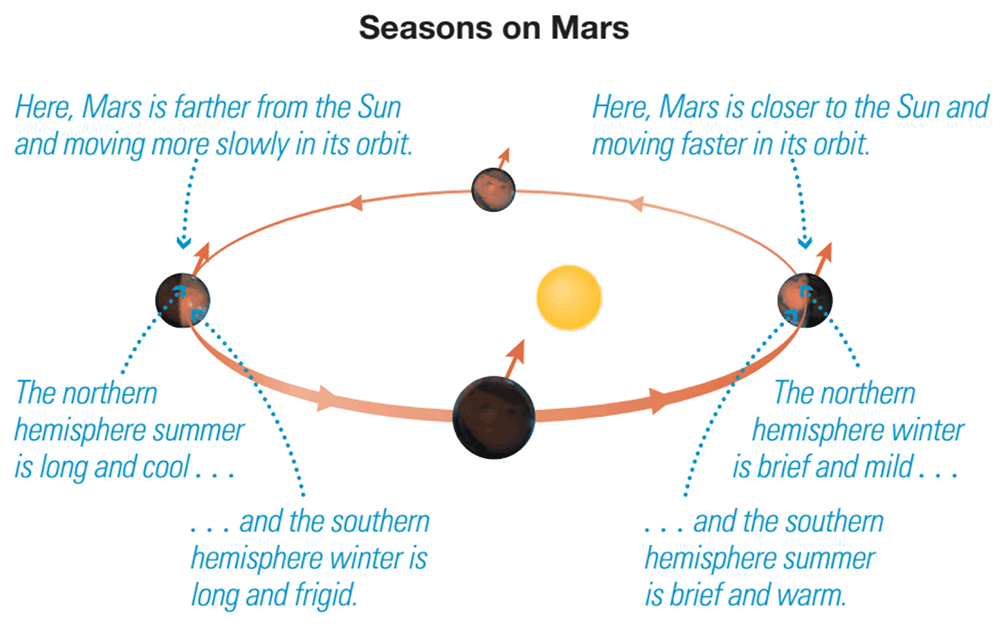The seasons have different characteristics in different parts of the world. High latitudes have more extreme seasons. For example, Vermont has much longer summer days and much longer winter nights than Florida. At the Arctic Circle (latitude 66½°), the Sun remains above the horizon all day long on the June solstice and never rises on the December solstice. The most extreme cases occur at the North and South Poles, where the Sun remains above the horizon for 6 months during each year, and below the horizon for the other 6 months.
Activity
Arctic Sun
Use the setup from earlier, with a bright light for the Sun on the center of a table, and a globe tilted at the correct angle (23½°). Start with your globe at the position of the June solstice, and rotate the globe a full 360° to represent one full day.
- As you rotate the globe, observe where it is daylight and where it is night. Which region of Earth stays in daylight for the entire day of the June solstice? Which region of Earth remains in night for that entire day?
- Now move the globe to the opposite side of the table, representing the December solstice, and answer the same questions from (1) again.
- Keep rotating your Earth to represent the passage of many days as you walk slowly toward the September equinox position. What do you notice about the size of the regions that are in continuous daylight or darkness as Earth moves from the solstice to the equinox positions?
- Continue walking around the table and spinning the globe, and pay particular attention to the North and South Poles. When does the Sun rise and set for the poles. Can you now explain where there are 6 months of daylight and 6 months of darkness at the poles?
- Regions located within the Arctic or Antarctic circles are sometimes called “the land of the midnight sun.” Explain why. Would it be equally valid to call them “the land of noon darkness?”
Teacher Notes. This is an optional activity that will help students understand how seasons become more extreme at higher latitudes, and also understand why there are 6 months of continuous daylight and darkness at the poles.
- Students should recognize that at the June solstice, all latitudes north of the Arctic Circle (latitude 66½°N) have 24 hours of daylight, while all latitudes south of the Antarctic Circle are in continuous darkness.
- At the December solstice, the situation is reversed, with 24 hours of daylight within the Antarctic Circle and continuous darkness within the Arctic Circle.
- The size of the region that is in continuous daylight or darkness gets smaller (that is, a smaller range of latitudes around the poles) as Earth moves from a solstice to an equinox.
- At the North pole, there is continuous daylight as Earth rotates from the time the Sun rises on the March equinox to the time when it sets at the September equinox, with the reverse occurring for the South Pole. In other words, the North Pole has 6 months of continuous daylight from the March to September equinox, then 6 months of night until the following March equinox. The opposite is true for the South Pole.
- Regions within the Arctic and Antarctic circles will all have 24 hours of daylight on one of the solstices (with the continuous daylight continuing longer at higher latitudes), and therefore have “midnight sun.” Of course, 6 months later, they have noon darkness.
Seasons also differ in equatorial regions, because the equator gets its most direct sunlight on the two equinoxes and its least direct sunlight on the solstices. As a result, instead of the four seasons experienced at higher latitudes, equatorial regions generally have rainy and dry seasons, with the rainy seasons coming when the Sun is higher in the sky.
Why Southern Hemisphere Seasons are Milder
We’ve seen that the seasons are caused by Earth’s axis tilt, not by Earth’s slightly varying distance from the Sun. Still, we might expect the varying orbital distance to play at least some role. Before you continue, explore why by discussing the following in small groups or with your whole class.
Group Discussion
Seasons by Hemisphere
- Look carefully at the lower left illustration in Figure 2.18. Based on what you see there, summer for the Northern Hemisphere occurs when ___________.
A. Earth is nearly at its closest distance to the Sun
B. Earth is at about its average distance from the Sun
C. Earth is nearly at its farthest distance to the Sun - Based on your answer to (1), which hemisphere would you expect to have more moderate seasons (meaning cooler summers and warmer winters)? Why?
- In fact, weather records show that Northern Hemisphere seasons are slightly more extreme than those of the Southern Hemisphere, with hotter summers and colder winters. Hypothesize about why this might be the case.
Teacher Notes. This topic and discussion is optional with regard to the seasons, but it will be useful later in the course when you are discussing weather and climate, so it is worth doing now to help set that stage. Notes:
- The answer C, because Figure 2.18 shows that Earth is farthest from the Sun on July 4, which is in Northern Hemisphere summer, and nearest to the Sun on January 3, which is in Northern Hemisphere winter.
- Thinking only about the answer to (1) we would expect that the farther distance during Northern Hemisphere summer would tend to keep things cooler, while the nearest distance during Northern Hemisphere winter would tend to keep things warmer. In other words, we would expect the Northern Hemisphere to have more moderate seasons, and the Southern Hemisphere to have the more extreme seasons.
- Note that the weather records are telling us the opposite of what we expected in (2), which means that there must be some other factor that overcomes the tendency expected from Earth’s varying distance alone. For this discussion, it’s worth just having students hypothesize about what that factor might be; the answer (distribution of land and oceans) is explained just below the discussion.
In your discussion, you should have found a surprise: Based on Earth’s varying distance, we would expect the Northern Hemisphere to have the more moderate seasons (because Northern winter occurs when Earth is closer to the Sun, and summer when Earth is farther), but it actually has the more extreme seasons. The main reason for this surprising fact becomes clear when you look at a map of Earth (Figure 2.19): Most of Earth’s land lies in the Northern Hemisphere, with far more ocean in the Southern Hemisphere. As you’ll notice at any beach, lake, or pool, water takes longer to heat or cool than soil or rock (largely because sunlight heats bodies of water to a depth of many meters while heating only the very top layer of land). The water temperature therefore remains fairly steady both day and night, while the ground can heat up and cool down dramatically. The Southern Hemisphere’s larger amount of ocean moderates its climate. The Northern Hemisphere, with more land and less ocean, heats up and cools down more easily, which is why it has the more extreme seasons.

Journal Entry
Your Seasons
Return to your earlier entry in which you wrote down your best guess about the cause of the seasons. Was your original guess correct? Write a paragraph or two about anything new that you’ve learned about the seasons. Be sure to mention anything that particularly surprised you, or any new facts you’ve learned that you find particularly interesting.
Seasons on Other Planets
Teacher Notes. This is an optional section, but the material is briefly mentioned in the video watched earlier, and some students will find it to be of interest. Be sure to note that by “seasons” we are referring only to temperatures, not to patterns involving plants or other life, since other planets do not have any life that responds to seasonal changes.
